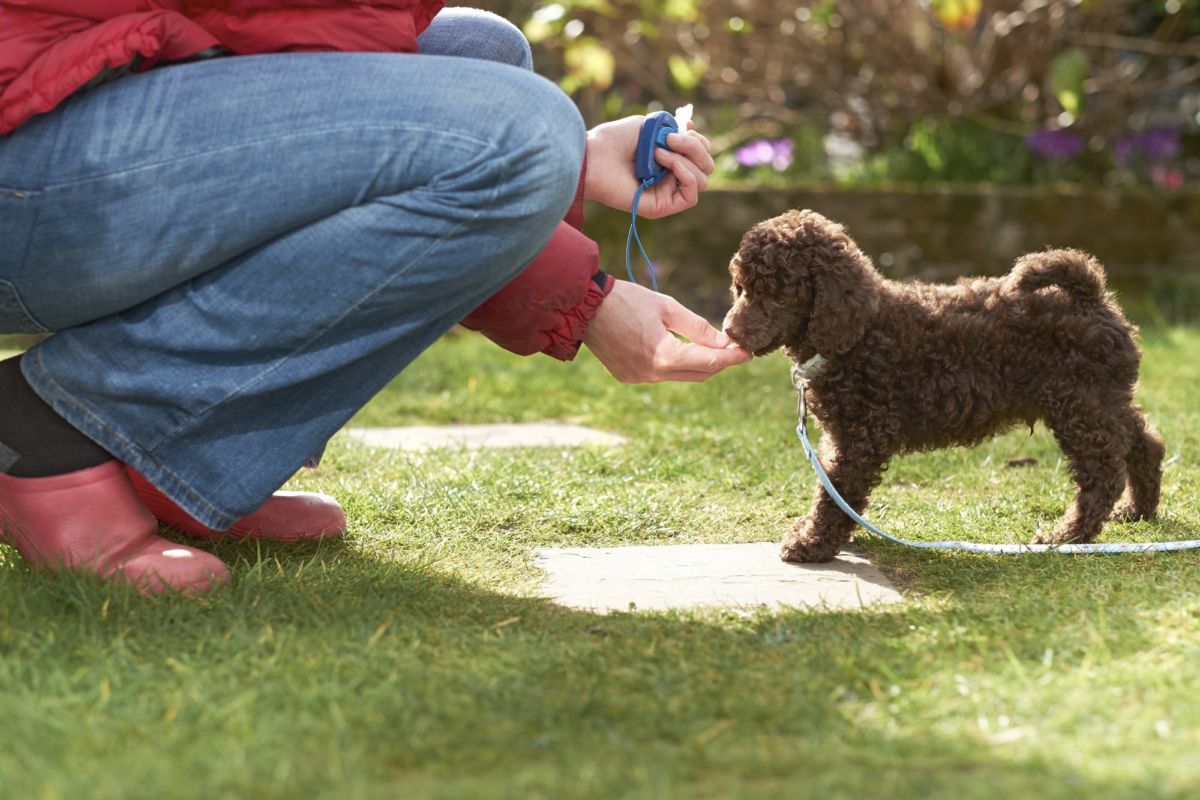Adopting a new puppy is like getting a new best friend. From walks around the block to cuddles on the couch, there’s no shortage of activities to enjoy together. While being a pet parent is tons of fun, you should also expect to do some work.
Puppies are adorable, but they’re also susceptible to bad behaviors — especially when they’re young. If you don’t take steps to discipline your puppy, it may exhibit poor habits in the future. Let’s go over some common negative behaviors and some tips for properly disciplining you puppy.

Bad Behaviors in Puppies
If you notice unwanted behaviors in your puppy, you’re not alone. Nearly every new puppy will act out now and then. Here are some negative behaviors to look out for:
- Hyperactivity
- Play biting
- Excessive chewing
- Separation anxiety
- Aggression
While some of these behaviors will naturally go away with age, others may persist without proper discipline methods.
How to Discipline a Puppy
To prevent your puppy from acting badly, it’s important to discipline it at an early age. With proper training, there’s no reason why your puppy shouldn’t grow into a kind, respectful adult. Here are 10 ways to discipline your puppy.
1. Use Positive Reinforcement
One of the best ways to discipline a puppy is through positive reinforcement. This tactic involves rewarding your puppy for good behavior, which encourages it to repeat this behavior in the future. You can positively reinforce actions through the following methods:
- Rewarding with treats or toys
- Giving your puppy verbal praise or petting
- Going on walks or playing
Every time your puppy does something correctly, follow up with a reward. For example, give it a treat when it listens to your commands. However, be careful not to accidentally reinforce negative behavior. It can be tempting to give your dog a treat to silence it when it’s barking loudly, but this could unintentionally encourage it to bark more.
2. Try Crate Training
If you’re trying to potty-train your puppy, crate training is a good place to start. In this technique, pet parents introduce their puppy to a safe space (such as a crate) where it’ll sleep. Since puppies are less likely to go potty in areas they associate with sleep, staying in a crate can reduce the risk of accidents. To properly crate train your puppy, follow these steps:
- Introduce your puppy to the crate: Encourage your puppy to enter the crate (making sure to leave the door open). You may have to use treats to incentivize it.
- Try closing the crate door: Once your puppy seems comfortable inside the crate, close the door. If it exhibits signs of stress, open it for some time, then try again.
- Leave it alone: After your puppy is settled, leave the room and see how it copes alone. If your puppy isn’t ready, it’ll let you know by whining or barking.
- Build up to longer time periods: This type of training can’t be done in a single day. Start with short periods of time (such as five minutes), then build up to hours at a time. And always remember to take your puppy outside to use the bathroom before leaving it in the crate.
Using a crate doesn’t just help with potty training — it also offers unique benefits for your puppy’s mental well-being. As your dog starts to enjoy the crate, it’ll treat it as a safe haven where it can relax when feeling overwhelmed.
3. Buy Chew Toys
It’s normal for puppies and even older dogs to chew on random objects. For teething puppies, chewing can minimize pain. For older dogs, chewing is a way to keep teeth clean. Unfortunately, if chewing isn’t kept under control, your furniture, shoes and household items might suffer as a result. To prevent your puppy from eating up your personal things, introduce it to chew toys. These toys offer the following benefits:
- Stress relief: If your dog is anxious (such as after hearing a loud noise), chew toys can help it relax.
- Improved dental health: The act of chewing a toy can remove plaque and tartar buildup.
- Mental stimulation: Chewing toys keeps puppies occupied and entertained.
- Reduced pain: Chew toys are known to soothe gums and reduce pain associated with teething.
- Reduced problematic chewing: If your puppy has a toy to chew, it’s less likely to chew random objects.
When choosing a chew toy, make sure it aligns with your puppy’s needs. For example, a small toy can be a choking hazard for a big dog. You should also have a few extra toys on hand — this way, if one breaks, you have another available.
4. Give Timeouts for Bad Behavior
Timeouts aren’t just for young children — they’re also a useful technique when puppy training. Similar to how you give treats for positive behavior, you should give timeouts for bad behavior. Here are a few tips on how to effectively give your puppy a timeout:
- Pick a good spot: Choose a spot where your puppy will feel comfortable but be separated from people and other pets (such as a crate or pet bed).
- Speak gently: Avoid yelling at your puppy, as this might frighten it. Instead, speak in a gentle yet assertive tone.
- Keep it brief: Timeouts don’t need to be long — even just a couple of minutes will get the message across.
Try not to engage with your puppy during its timeout. After the timeout is over, your puppy should connect it with its bad behavior and be discouraged from repeating this behavior.
5. Provide Regular Exercise and Mental Stimulation
Just like people, dogs can’t perform at their best when they’re unhappy. If you want your puppy to exhibit desirable behavior, you need to create a happy environment for it by providing regular exercise and mental stimulation. These needs can be met through the following methods:
- Walks: Try to take your dog for a walk every day for at least 20 to 30 minutes.
- Fetch: Games of fetch are a great way to get your dog up and running.
- Scavenger hunts: Set up a scavenger hunt to mentally stimulate your dog.
- Toys: Chew and puzzle toys can keep your pet mentally occupied.
- Tricks: Teaching your dog a new trick provides mental stimulation, exercise and training all in one.
Ultimately, disciplining your dog is a two-way street. You must set up the optimal atmosphere before you can expect your puppy’s behavior to change.
6. Take Toys Away
A common way to discipline children is taking away something they enjoy, such as a cell phone or computer. Believe it or not, this same logic applies to dogs. While your puppy probably isn’t playing with electronics, chances are it has a favorite toy or two. If your puppy is misbehaving, try taking away its toys. This method is most effective when you follow these tips:
- Take away multiple toys: Your dog won’t get the message if you only take one or two toys.
- Pick its favorite toys: For this disciplinary method to work, you should focus on the toys your dog values.
- Repeat this method: If taking away your dog’s toys doesn’t seem to have an effect, don’t give up on the method — it works best when done multiple times.
You don’t have to hold your dog’s toys hostage for too long — once your puppy settles down and starts behaving again, feel free to reintroduce the toys. Ideally, your puppy will realize it gets rewarded for good behavior.
7. Use Distractions
Even the most well-behaved dogs neglect their training now and then. For example, your puppy might behave perfectly at home but get too excited or loud when it’s at the dog park. If it refuses to listen to commands, try distracting it with one of these ideas:
- Shift locations: Move away from whatever is triggering your puppy to act out.
- Offer a treat: Show your puppy a treat to grab its attention (but don’t give it the treat until it calms down).
- Use a toy: If your puppy has a favorite toy, you can use it to distract it.
When visiting an area where you know your dog may act out, always try to bring a distraction with you.
8. Avoid Certain Forms of Play
While every dog likes to play, some types of play are known to encourage bad behavior. You can try these gentler games:
- Fetch
- Scavenger hunts
- Hide and seek
- Obstacle courses
If you don’t have time to play with your puppy yourself, invest in a few toys to keep it busy. It’s also a good idea to take it for puppy play dates with other dogs, as this will teach it how to socialize properly.
9. Understand Punishment vs. Discipline
There’s a fine line between punishment and discipline. The former can hurt your dog’s self-esteem and weaken your relationship, while the latter discourages negative behavior in a safe, helpful manner.
You’ll definitely experience moments when your furry friend frustrates you. From loud whining and chewing to aggression and puppy bites, there are plenty of negative dog behaviors. However, it’s important to remain patient and not lose your temper. After all, you want your puppy to listen to you out of respect, not fear.

10. Work With a Professional Dog Trainer
Are you struggling to connect with your puppy and get it to listen to your commands? In these cases, it might be time to turn to an expert. Dog trainers understand puppies better than anyone else and know exactly how to bring out the best in every canine. Not only can they help with unwanted behaviors, but they can also address any unique concerns you have (such as separation anxiety, aggression or whatever else may be affecting your puppy).
While you can try dog training at any age, it tends to be most effective when puppies are young and more susceptible to change. At Pride & Prejudoodles, we provide happy, healthy and fully trained puppies. Our training, which begins as early as possible, covers the following:
- House training
- Obedience commands
- Socialization
- Leash walking
- Prevention of negative behaviors
In addition to our training programs, we offer coat and health testing. Our goal is to take care of the training and discipline so you can enjoy as much time with your puppy as possible. Contact us today to learn more!
